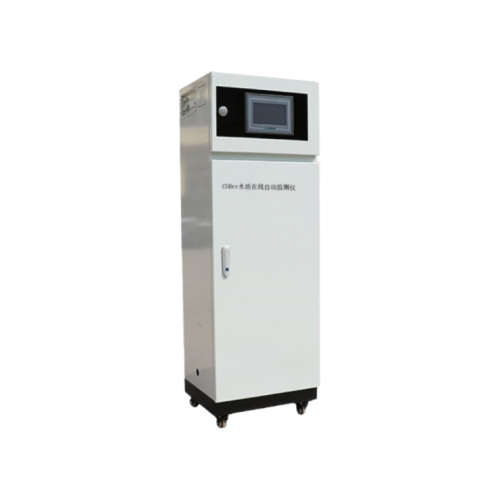
CODcr Analyzer
Contact Now
Heating a mixture of water sample, potassium dichromate digestion solution, silver sulfate solution (silver sulfate as a catalyst can more effectively oxidize linear fatty compounds), and concentrated sulfuric acid to 175 ℃ will cause a color change after the oxidation of organic matter in the solution by dichromate ions. The analyzer detects this color change and converts it into COD value output. The amount of dichromate ions consumed is equivalent to the amount of oxidizable organic matter.
Potassium permanganate solution and sulfuric acid solution are added to the sample, mixed and digested. Potassium permanganate oxidizes the organic pollutants in the sample and the color of the water sample changes. The monitor detects this color change and converts it into a permanganate index value and outputs it.
Under alkaline medium conditions, potassium persulfate is used as an oxidant to oxidize ammonia nitrogen and nitrite nitrogen in the sample into nitrates, and most of the organic nitrogen compounds in the sample are oxidized into nitrates. NO3- reacts with resorcinol in an acidic environment. Within a certain concentration range, the color depth is proportional to its concentration. The absorbance is measured at a wavelength of 375nm and converted into a total nitrogen concentration value after correction by the calibration curve.
In the presence of potassium persulfate, the nitrogen-containing compounds in the water sample are completely converted into nitrate nitrogen after high digestion. The absorbance of the complex is measured by a spectrophotometer at a wavelength of 220nm and converted into a total nitrogen value.
After the water sample and the masking agent are mixed, ammonia nitrogen in the form of free ammonia or ammonium ions reacts with the salicylic acid colorimetric reagent in an alkaline environment and in the presence of a sensitizer to form a colored complex. The absorbance of the complex is measured by a spectrophotometer to calculate the concentration of ammonia nitrogen in the water sample.
Ammonia nitrogen in the form of free ammonia or ammonium ions reacts with Nessler's reagent to form a light reddish-brown complex. The absorbance of the complex is measured by a spectrophotometer to calculate the concentration of ammonia nitrogen in the water sample.
The mixture of water sample, catalyst solution and strong oxidant digestion solution is heated to 120°C. Polyphosphate and other phosphorus-containing compounds in the water sample are digested and oxidized by strong oxidants under acidic conditions of high temperature and pressure to generate phosphate. In the presence of a catalyst, the phosphate ions generate a colored complex in a strong acid solution containing molybdate. The absorbance of the complex is measured by a spectrophotometer to calculate the concentration of total phosphorus.
This product uses the resorcinol spectrophotometric method to determine nitrate nitrogen. Resorcinol reacts with nitrate nitrogen to generate a colored compound, and the absorbance of the compound is measured by a spectrophotometer to calculate the concentration of nitrate nitrogen.
This product uses N-1-naphthylethylenediamine spectrophotometry to determine nitrite nitrogen. In an acidic solution, nitrite ions undergo a diazotization reaction with sulfonamide, and then couple with N-(1-naphthyl)-ethylenediamine to generate a purple-red dye. By measuring the absorbance of the dye at a specific wavelength (such as 540nm), the content of nitrite can be quantitatively analyzed.
This product uses the isonicotinic acid-barbituric acid spectrophotometry to determine the concentration of cyanide in water samples. After the water sample and the regulator are mixed, the cyanide ions in the water sample react with chloramine T to generate cyanogen chloride, which reacts with isonicotinic acid to generate glutaraldehyde after hydrolysis, and then reacts with barbituric acid to generate a purple-blue compound. The monitor detects the change in color and converts this change into a vapor value for output.
This product uses fluorine reagent spectrophotometry to determine the fluoride concentration in water. Fluoride ions, in an acetate buffer medium at pH 4.1, react with fluorine reagent and lanthanum nitrate to form a blue ternary complex. The color intensity is proportional to the fluoride ion concentration. Fluoride (F-) is quantitatively determined at a wavelength of 620nm.
This product uses 4-aminoantipyrine spectrophotometry to determine the concentration of volatile phenols in water. Photoelectric colorimetry is used for determination. After the water sample and the regulator are mixed, the volatile phenols in the water sample react with the indicator in the presence of a sensitizer to generate a colored complex. The monitor detects the change in color and converts this change into a volatile phenol value for output.

Privacy statement: Your privacy is very important to Us. Our company promises not to disclose your personal information to any external company with out your explicit permission.

Fill in more information so that we can get in touch with you faster
Privacy statement: Your privacy is very important to Us. Our company promises not to disclose your personal information to any external company with out your explicit permission.